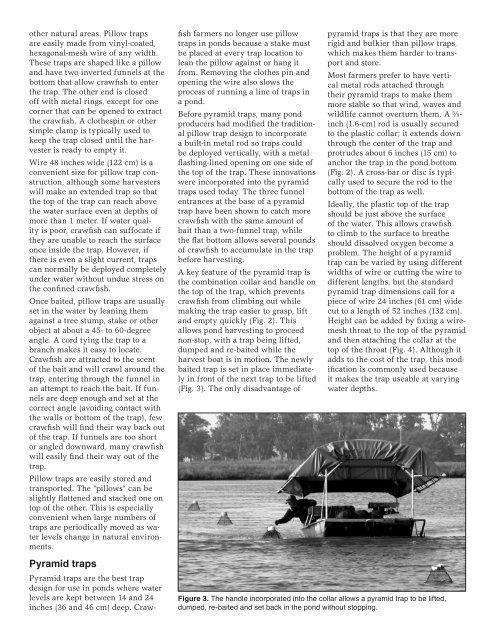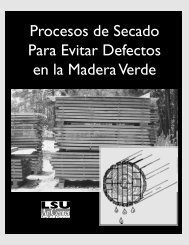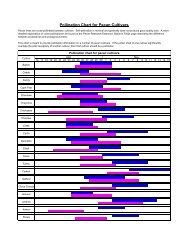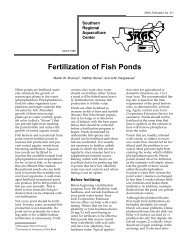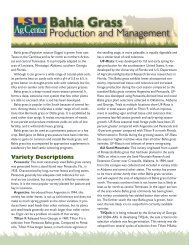Crawfish Trap Design and Construction - SRAC Fact Sheets
Crawfish Trap Design and Construction - SRAC Fact Sheets
Crawfish Trap Design and Construction - SRAC Fact Sheets
You also want an ePaper? Increase the reach of your titles
YUMPU automatically turns print PDFs into web optimized ePapers that Google loves.
other natural areas. Pillow traps<br />
are easily made from vinyl-coated,<br />
hexagonal-mesh wire of any width.<br />
These traps are shaped like a pillow<br />
<strong>and</strong> have two inverted funnels at the<br />
bottom that allow crawfish to enter<br />
the trap. The other end is closed<br />
off with metal rings, except for one<br />
corner that can be opened to extract<br />
the crawfish. A clothespin or other<br />
simple clamp is typically used to<br />
keep the trap closed until the harvester<br />
is ready to empty it.<br />
Wire 48 inches wide (122 cm) is a<br />
convenient size for pillow trap construction,<br />
although some harvesters<br />
will make an extended trap so that<br />
the top of the trap can reach above<br />
the water surface even at depths of<br />
more than 1 meter. If water quality<br />
is poor, crawfish can suffocate if<br />
they are unable to reach the surface<br />
once inside the trap. However, if<br />
there is even a slight current, traps<br />
can normally be deployed completely<br />
under water without undue stress on<br />
the confined crawfish.<br />
Once baited, pillow traps are usually<br />
set in the water by leaning them<br />
against a tree stump, stake or other<br />
object at about a 45- to 60-degree<br />
angle. A cord tying the trap to a<br />
branch makes it easy to locate.<br />
<strong>Crawfish</strong> are attracted to the scent<br />
of the bait <strong>and</strong> will crawl around the<br />
trap, entering through the funnel in<br />
an attempt to reach the bait. If funnels<br />
are deep enough <strong>and</strong> set at the<br />
correct angle (avoiding contact with<br />
the walls or bottom of the trap), few<br />
crawfish will find their way back out<br />
of the trap. If funnels are too short<br />
or angled downward, many crawfish<br />
will easily find their way out of the<br />
trap.<br />
Pillow traps are easily stored <strong>and</strong><br />
transported. The “pillows” can be<br />
slightly flattened <strong>and</strong> stacked one on<br />
top of the other. This is especially<br />
convenient when large numbers of<br />
traps are periodically moved as water<br />
levels change in natural environments.<br />
Pyramid traps<br />
Pyramid traps are the best trap<br />
design for use in ponds where water<br />
levels are kept between 14 <strong>and</strong> 24<br />
inches (36 <strong>and</strong> 46 cm) deep. Craw-<br />
fish farmers no longer use pillow<br />
traps in ponds because a stake must<br />
be placed at every trap location to<br />
lean the pillow against or hang it<br />
from. Removing the clothes pin <strong>and</strong><br />
opening the wire also slows the<br />
process of running a line of traps in<br />
a pond.<br />
Before pyramid traps, many pond<br />
producers had modified the traditional<br />
pillow trap design to incorporate<br />
a built-in metal rod so traps could<br />
be deployed vertically, with a metal<br />
flashing-lined opening on one side of<br />
the top of the trap. These innovations<br />
were incorporated into the pyramid<br />
traps used today. The three funnel<br />
entrances at the base of a pyramid<br />
trap have been shown to catch more<br />
crawfish with the same amount of<br />
bait than a two-funnel trap, while<br />
the flat bottom allows several pounds<br />
of crawfish to accumulate in the trap<br />
before harvesting.<br />
A key feature of the pyramid trap is<br />
the combination collar <strong>and</strong> h<strong>and</strong>le on<br />
the top of the trap, which prevents<br />
crawfish from climbing out while<br />
making the trap easier to grasp, lift<br />
<strong>and</strong> empty quickly (Fig. 2). This<br />
allows pond harvesting to proceed<br />
non-stop, with a trap being lifted,<br />
dumped <strong>and</strong> re-baited while the<br />
harvest boat is in motion. The newly<br />
baited trap is set in place immediately<br />
in front of the next trap to be lifted<br />
(Fig. 3). The only disadvantage of<br />
pyramid traps is that they are more<br />
rigid <strong>and</strong> bulkier than pillow traps,<br />
which makes them harder to transport<br />
<strong>and</strong> store.<br />
Most farmers prefer to have vertical<br />
metal rods attached through<br />
their pyramid traps to make them<br />
more stable so that wind, waves <strong>and</strong><br />
wildlife cannot overturn them. A 5 ⁄8inch<br />
(1.6-cm) rod is usually secured<br />
to the plastic collar; it extends down<br />
through the center of the trap <strong>and</strong><br />
protrudes about 6 inches (15 cm) to<br />
anchor the trap in the pond bottom<br />
(Fig. 2). A cross-bar or disc is typically<br />
used to secure the rod to the<br />
bottom of the trap as well.<br />
Ideally, the plastic top of the trap<br />
should be just above the surface<br />
of the water. This allows crawfish<br />
to climb to the surface to breathe<br />
should dissolved oxygen become a<br />
problem. The height of a pyramid<br />
trap can be varied by using different<br />
widths of wire or cutting the wire to<br />
different lengths, but the st<strong>and</strong>ard<br />
pyramid trap dimensions call for a<br />
piece of wire 24 inches (61 cm) wide<br />
cut to a length of 52 inches (132 cm).<br />
Height can be added by fixing a wiremesh<br />
throat to the top of the pyramid<br />
<strong>and</strong> then attaching the collar at the<br />
top of the throat (Fig. 4). Although it<br />
adds to the cost of the trap, this modification<br />
is commonly used because<br />
it makes the trap useable at varying<br />
water depths.<br />
Figure 3. The h<strong>and</strong>le incorporated into the collar allows a pyramid trap to be lifted,<br />
dumped, re-baited <strong>and</strong> set back in the pond without stopping.


